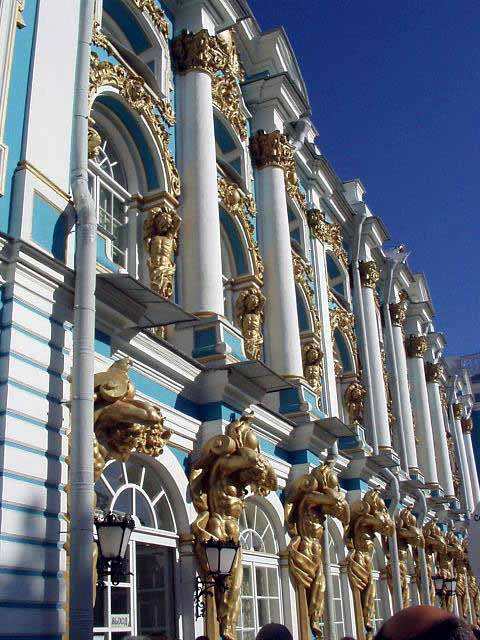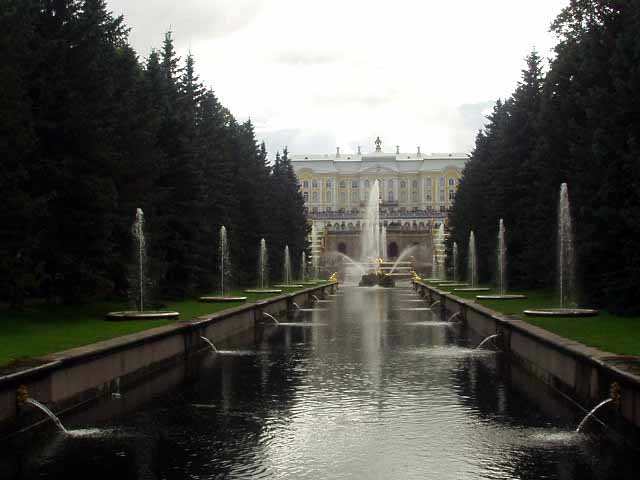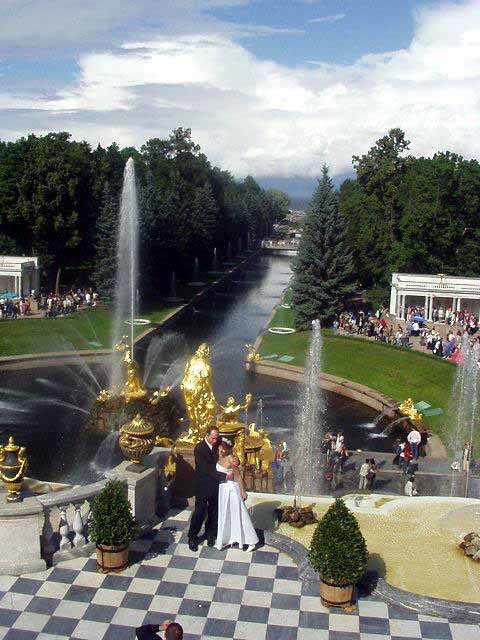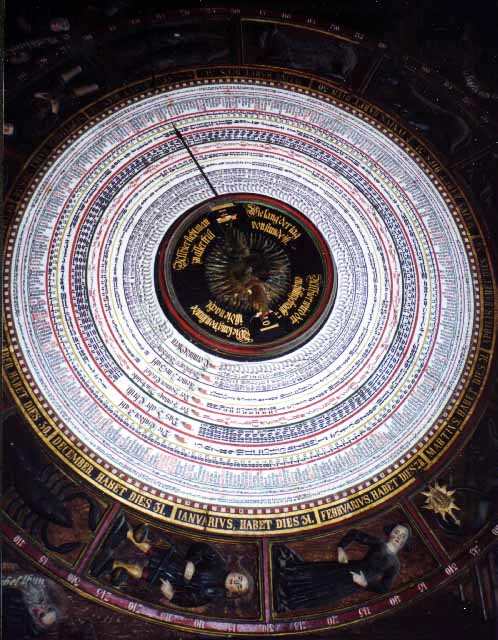--------- Scandinavia - August 2003 ---------
Oslo, Norway and Stockholm, Sweden Helsinki, Finland and St. Petersburg, Russia Tallinn, Estonia and Rostock, Germany Copenhagen, Denmark
--------- Dover, England ---------
The Celebrity Constellation was our biggest cruise ship so far, at 91,000 tons, 965 feet long and carrying up to 1950 passengers. It went into service this year. The aft dining room windows are visible here with the huge penthouse suites on the decks above it.

The "White Cliffs of Dover" as seen from the upper deck of the Constellation. The North Sea was calm on our crossing to Oslo and it was hard to know we were underway.


The "White Cliffs of Dover" as seen from the upper deck of the Constellation. The North Sea was calm on our crossing to Oslo and it was hard to know we were underway.

------------ Oslo, Norway ------------
We passed small islands early on our second day, weaving our way in to Oslo, our first port. Here in the harbor, sailboat masts can be seen all over and we saw many kayaks and ferries as well.

This was our first view of the Vigeland Sculpture Park. The park contains 80 acres of grounds with 150 sculptures, by Gustav Vigeland. It was a life long project for the sculptor.


This was our first view of the Vigeland Sculpture Park. The park contains 80 acres of grounds with 150 sculptures, by Gustav Vigeland. It was a life long project for the sculptor.

This is one of the many large sculptures, done in bronze. Others are done in stone.


These large rose beds were only a small part of the park plantings. Tourists weren't the only visitors, the locals were enjoying the park as much as we were.

Our perky Norwegian guide (With the yellow umbrella.) explains the origins of the park. The fountain behind her is much more massive than it appears in the photo.

The pillar of life is at the highest point in the park. Amazingly, this 50 foot tall piece of interconnected human shapes was made from a single piece of granite.

The Norwegian Folk Museum contained numerous full size buildings. This one, a reproduction, has a sod roof. The skill and ingenuity of the Norwegians in the construction of these structures is very impressive.

The Viking Museum had several full size ships, all with original planking. This one was used only in a burial while another one was an actual working ship. These could be and apparently were, rowed and sailed in the open ocean.

Our perky Norwegian guide (With the yellow umbrella.) explains the origins of the park. The fountain behind her is much more massive than it appears in the photo.

The pillar of life is at the highest point in the park. Amazingly, this 50 foot tall piece of interconnected human shapes was made from a single piece of granite.

The Norwegian Folk Museum contained numerous full size buildings. This one, a reproduction, has a sod roof. The skill and ingenuity of the Norwegians in the construction of these structures is very impressive.

The Viking Museum had several full size ships, all with original planking. This one was used only in a burial while another one was an actual working ship. These could be and apparently were, rowed and sailed in the open ocean.

Some of the old fortress and city walls as seen from our ship leaving Oslo.

Newer buildings. The Holmenkollen ski jump can be seen on the far mountain.


Newer buildings. The Holmenkollen ski jump can be seen on the far mountain.

------------ Stockholm, Sweden ------------
Our Stockholm tour guide, Dr. Fisher, is a professor of religion at the local university. Stockholm is the gateway between Lake Malaren and the Baltic Sea, so there are locks with adjacent islands, which are all part of the city. High speed surface trains were visible, noisily scurrying along their tracks, much like subways in London, except above ground, transporting people from place to place.

Our tour was mostly devoted to the Vasa Museum. Here we view the recovered Vasa, which lay on the bottom of the harbor from 1628 until 1961. The ship had apparently been designed for 40 medium size cannons but had been unwisely fitted out with 64 larger guns. She was struck with an unexpected gust of wind and capsized and sunk on her maiden voyage. Many of the cannons were later retrieved using a diving bell, but the hull was on the bottom for over 300 years.
This view of the transom, shows some of the heavy relief carving. The wood had been painted and the museum had several samples which were restored to original appearance.
The Stockholm waters were full of all manner of interesting boats, work boats as well as pleasure craft. It's a spot that would fascinate any boater.

Our tour was mostly devoted to the Vasa Museum. Here we view the recovered Vasa, which lay on the bottom of the harbor from 1628 until 1961. The ship had apparently been designed for 40 medium size cannons but had been unwisely fitted out with 64 larger guns. She was struck with an unexpected gust of wind and capsized and sunk on her maiden voyage. Many of the cannons were later retrieved using a diving bell, but the hull was on the bottom for over 300 years.

This view of the transom, shows some of the heavy relief carving. The wood had been painted and the museum had several samples which were restored to original appearance.

The Stockholm waters were full of all manner of interesting boats, work boats as well as pleasure craft. It's a spot that would fascinate any boater.

------------ Helsinki, Finland ------------
The ship provided a shuttle bus to downtown from the pier, which we took. Our driver looped around the waterfront to give us our bearings and then dropped us at a transfer station a few blocks into town. We walked through a city park, but on the sunny side of the street since it was quite cold. At 52 degrees North, it's still quite chilly at 9 AM, even in August. Here we arrived at the market and things were well underway. Although the market is on the waterfront, we saw mostly vegetables and souvenirs for sale, not many fish until later in the afternoon.

This is the Uspenski Orthodox Cathedral. It's situated on a hill overlooking the harbor and is quite magnificent.
The Lutheran Cathedral, was designed by Carl Ludvig Engel. We went inside shortly before a service was to begin.
We took a 90 minute harbor tour on a small craft that just barely fit under several of the bridges like the one in this picture.
The sun was well up for our return walk back to the bus. The park is quite nice and popular with the residents.

This is the Uspenski Orthodox Cathedral. It's situated on a hill overlooking the harbor and is quite magnificent.

The Lutheran Cathedral, was designed by Carl Ludvig Engel. We went inside shortly before a service was to begin.

We took a 90 minute harbor tour on a small craft that just barely fit under several of the bridges like the one in this picture.

The sun was well up for our return walk back to the bus. The park is quite nice and popular with the residents.

------------ St. Petersburg, Russia ------------
The Hermitage Museum was the "must see" of this stop so it was the first of four tours that we took during the two days that our ship was there. There is so much to see inside the museum and so many visitors that taking a picture of one thing means missing something else. So, we just bought a book and skipped taking any pictures here.
This is inside the dome of the Cathedral of St. Isaac of Dalmalia. It is 331 feet high and coated with over 200 pounds of pure gold on the outside. We thought the inside was more spectacular than the outside.
This is inside the dome of the Cathedral of St. Isaac of Dalmalia. It is 331 feet high and coated with over 200 pounds of pure gold on the outside. We thought the inside was more spectacular than the outside.

This is the Church of Our Savior on Spilled Blood, constructed in 1907 with its 9 onion domes of gold and ceramics. It is built over the spot where Alexander II was assassinated, hence its unusual name.

Our second day started with Catherine's Place. It is situated on 1,482 acres of landscaped gardens and parklands 17 miles South of St. Petersburg. There are formal English gardens to South with French gardens to the East. The building is nearly 1000 feet long.


One of the many floor mosaics inside Catherine's Place. The entire palace has been rennovated after being nearly destroyed during WWII and is now open as a museum.

Our afternoon tour took us 22 miles West of St. Petersburg to the fountains at Peterhof Palace. This is a view looking toward the palace. The fountains are fed by natural streams. The palace was built in 1723 for Peter The Great. There are 300 acres of parks and 173 fountains.
The gold used in "The Samson Fountain" is quite generous. This is where Sampson is holding the jaws of the lion open while water sprays upward from his open mouth.

Our afternoon tour took us 22 miles West of St. Petersburg to the fountains at Peterhof Palace. This is a view looking toward the palace. The fountains are fed by natural streams. The palace was built in 1723 for Peter The Great. There are 300 acres of parks and 173 fountains.

The gold used in "The Samson Fountain" is quite generous. This is where Sampson is holding the jaws of the lion open while water sprays upward from his open mouth.

Looking down on The Samson Fountain with a wedding couple posing for their picture.


The Russian Orthodox Church of St. Alexander Nevski, near the Palace Square in Upper Old Town was built in the style of Moscow churches of the 17th century. The interior contains a number of interesting icons and mosaics. Old Town was founded in 1154.


------------ Tallinn, Estonia ------------
The Russian Orthodox Church of St. Alexander Nevski, near the Palace Square in Upper Old Town was built in the style of Moscow churches of the 17th century. The interior contains a number of interesting icons and mosaics. Old Town was founded in 1154.
Looking down from Upper Old Town. This is separated from Lower Old Town by a thick wall, some of which remains today. Annamarie was able to buy a nice plate here.
The plaza in Lower Old Town. The streets were pretty narrow, so it's mostly foot traffic.
Looking down from Upper Old Town. This is separated from Lower Old Town by a thick wall, some of which remains today. Annamarie was able to buy a nice plate here.

The plaza in Lower Old Town. The streets were pretty narrow, so it's mostly foot traffic.

------------ Rostock, Germany ------------
Rostock is home to the International Garden Exhibition and Fair, which is held every ten years. 2003 happened to be one of the years. This is one of the floating gardens, the sculptures are a fantasy replication of the plant's reproductory apparatus with the yellow tubes representing the flow of pollen.


We continued downtown to St. Mary's Church, home of the famous astronomical clock. Our guide did not offer to explain how it works, but it does look impressive.


These building restorations in the downtown, have been completed within the last ten years. We thought they were quite well done.


------------ Copenhagen, Denmark ------------
This was one of many bridges we went under on our harbor tour. The boats are made to just barely fit under some of them.

Al took this picture from the bus. The many bicycles are a way of life here. Mostly they are left unlocked and are much more in use than cars here. We learned that the government tax on a new car is 180% of the purchase price. Taxis are charged at 25% but can't be sold as non-taxis for three years.
Tivoli Gardens. This concession looks like a version of bumper cars, only with boats. This amusement park was the inspiration for Disney Land in the US. It's been in operation for 160 years and shows no signs of slowing down.
One of several playhouses at Tivoli Gardens with a performance in progress.
A must see in Copenhagen, the "Little Mermaid" at Langelinie. The light was very poor but that didn't slow down the crowd. This must be the most photographed of anything in Denmark.
From here we sailed back to Dover, a bus to Heathrow Airport, and our flight back to Seattle. Crossing the North Sea, our ship experienced 55 knot winds and 18 foot seas during the night, but Annamarie never woke up and we arrived in Dover right on schedule. That's certainly one advantage of a large ship.
Index

Al took this picture from the bus. The many bicycles are a way of life here. Mostly they are left unlocked and are much more in use than cars here. We learned that the government tax on a new car is 180% of the purchase price. Taxis are charged at 25% but can't be sold as non-taxis for three years.

Tivoli Gardens. This concession looks like a version of bumper cars, only with boats. This amusement park was the inspiration for Disney Land in the US. It's been in operation for 160 years and shows no signs of slowing down.

One of several playhouses at Tivoli Gardens with a performance in progress.

A must see in Copenhagen, the "Little Mermaid" at Langelinie. The light was very poor but that didn't slow down the crowd. This must be the most photographed of anything in Denmark.

From here we sailed back to Dover, a bus to Heathrow Airport, and our flight back to Seattle. Crossing the North Sea, our ship experienced 55 knot winds and 18 foot seas during the night, but Annamarie never woke up and we arrived in Dover right on schedule. That's certainly one advantage of a large ship.
So once again, we had a wonderful cruise. Getting to meet and know our dinner companions was also part of the fun of the trip.